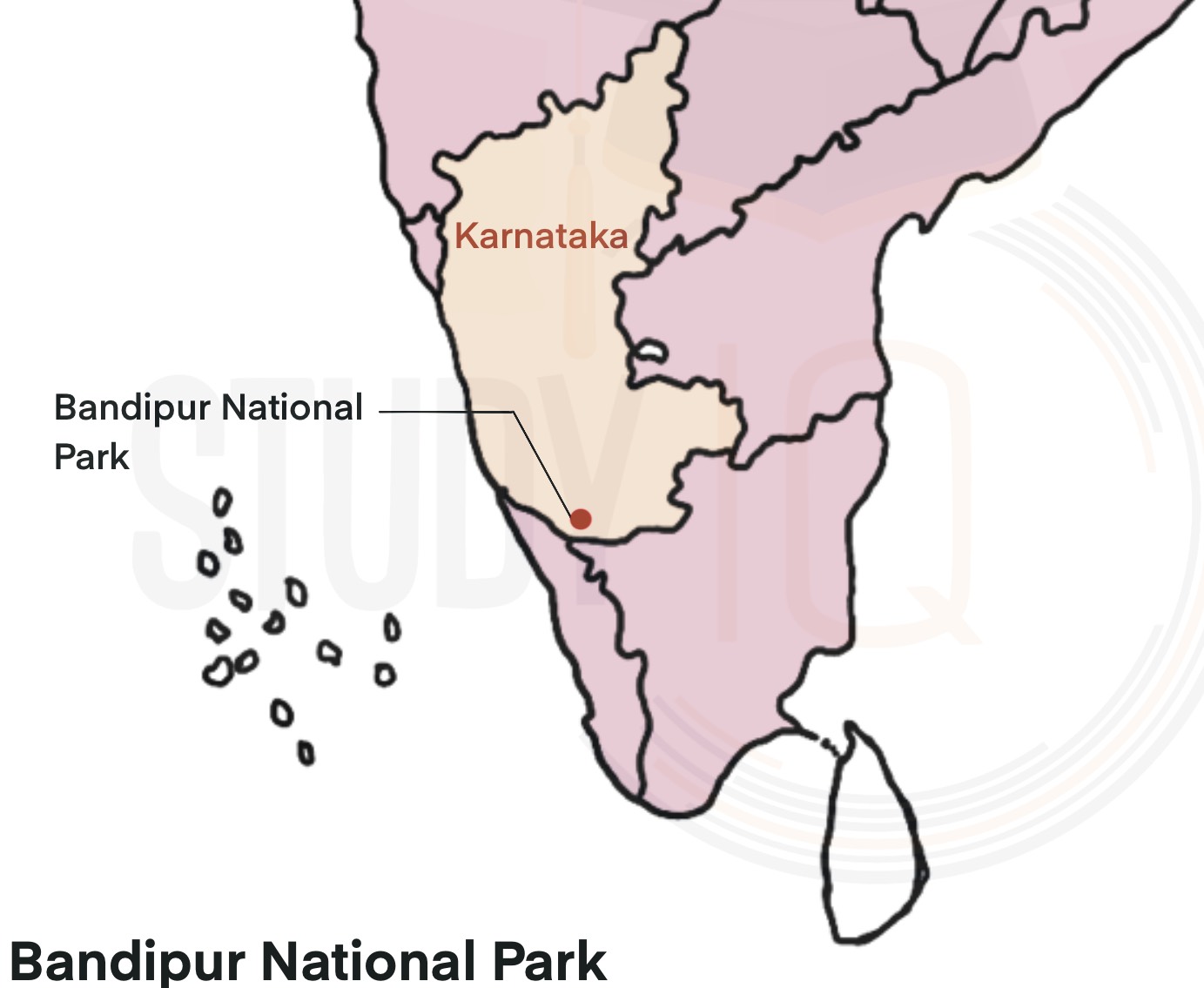Table of Contents
The Karnataka Forest Department has imposed restrictions on the annual jathra of Beladakuppe Sri Mahadeshwaraswamy Temple which is in the core area of Bandipur Tiger Reserve.
About Bandipur Tiger Reserve (BTR)
- Location: Mysore and Chamarajanagar districts of southern Karnataka.
- It is located at the ecological confluence of the Western and Eastern Ghats.
- Rivers: Kabini & Moyar
- Flora: Diverse vegetation of dry deciduous to tropical mixed deciduous.
- Trees: Teak, rosewood, sandalwood, Indian laurel, Indian kino tree, bamboo etc.
- Fauna: Bengal tigers, Indian elephants, sloth bears, dholes, four-horned antelopes, gray langurs, bonnet macaques etc.
- It is surrounded by Mudumalai Tiger Reserve, Wayanad Wildlife Sanctuary and e Bandipur and Nagarahole Tiger Reserve.
| Facts |
|
Bandipur Tiger Reserve Landscape
Numerous rivers and streams, including the Kabini, Moyar, and Nugu, traverse the park, providing vital water for its flora and fauna.
The landscape of Bandipur Tiger Reserve is varied and ranges from hills and valleys to flat plains. The park is home to the highest peak in the Bandipur forest range, called Himavad Gopalaswamy Betta, which stands at an altitude of 1,450 meters above sea level. Bandipur Tiger Reserve is also known for its unique vegetation, which includes moist deciduous forests, dry deciduous forests, and scrublands.
Bandipur Tiger Reserve Map
Here is a map of Bandipur Tiger Reserve given below for a better understanding:

Bandipur Tiger Reserve Fauna
The park’s topography and diverse vegetation provide a habitat for a variety of wildlife species, with some of its most noteworthy species comprising:
| Faunal Specie | Scientific Name | Unique Features |
| Bengal Tiger | Panthera tigris tigris | Bandipur has one of the highest densities of Bengal tigers in India, with an estimated population of 120 tigers as of 2021. The park is also part of the Nilgiri Biosphere Reserve, which is a designated UNESCO World Heritage Site. |
| Indian Elephant | Elephas maximus indicus | Bandipur is home to a significant population of Indian elephants, with an estimated 300-350 individuals. The park is also part of the Nilgiri Biosphere Reserve, which is a designated UNESCO World Heritage Site. |
| Gaur | Bos gaurus | The largest wild cattle species in the world, gaur are found in significant numbers in Bandipur. They are known for their impressive size, with males weighing up to 1,500 kg, and their distinctive brown coats and white stockings. |
| Indian Wild Dog | Cuon alpinus | Also known as dhole, Indian wild dogs are one of the top predators in Bandipur. They hunt in packs and are known for their unique vocalizations, which sound like high-pitched whistles. Bandipur is home to an estimated 100-120 dholes. |
| Sloth Bear | Melursus ursinus | Sloth bears are nocturnal and elusive, making them difficult to spot in the wild. Bandipur is home to a small population of these bears, which are known for their long, shaggy coats and distinctive white V-shaped markings on their chest. |
| Sambar | Rusa unicolor | Sambar deer are the largest deer species in India and are commonly found in Bandipur. They are known for their distinctive antlers, which can have up to three times on each side, and their shaggy, dark brown coat. |
| Spotted Deer | Axis axis | Also known as chital, spotted deer is one of the most common deer species in India. They are easily recognized by the distinctive white spots on their reddish-brown coat. |
| Barking Deer | Muntiacus muntjak | Barking deer are also known as muntjacs and are the smallest deer species in India. They are known for their distinctive bark, which sounds like a dog’s bark, and their short, dark brown coat. |
| Stripe-necked Mongoose | Herpestes vitticollis | These small carnivores are found in Bandipur and are easily recognized by their distinctive striped necks. They are known for their ability to hunt snakes and other small prey and are often seen in the early morning or late afternoon. |
| Indian Pangolin | Manis crassicaudata | These unique creatures are covered in scaly armour made of keratin, which helps protect them from predators. They are found in Bandipur and are often seen foraging for ants and termites on the forest floor. |
| King Cobra | Ophiophagus hannah | One of the most venomous snake species in the world, king cobras are found in Bandipur and are easily recognized by their distinctive hood, which they use to intimidate predators. They are also known for their ability to hunt other snake species, including other venomous snakes. |
Bandipur Tiger Reserve Flora
The flora of Bandipur Tiger Reserve is diverse, with several important categories and species present, such as:
| Flora Category | Important Species | Unique Features |
| Trees | Rosewood, Teak, Sandalwood, Indian Laurel, Indian Kino, Flame of the Forest | Rosewood is used for carving and furniture, while Sandalwood is famous for its fragrance and is used for making incense and perfumes |
| Shrubs | Bamboo, Grewia, Indian Gooseberry, Hill Turmeric | Bamboo is used in construction and handicrafts, while Hill Turmeric is used in traditional medicine |
| Herbs | Tridax, Parthenium, False Daisy, Indian Acalypha | Parthenium and False Daisy are invasive species and can cause harm to native flora and fauna |
| Grasses | Kans, Dharba, Cymbopogon | Dharba grass is considered sacred and used in religious ceremonies |
Bandipur Tiger Reserve also has a variety of climbers, creepers, and epiphytes that are an integral part of the forest ecosystem.
Bandipur Tiger Reserve Tourism
Bandipur Tiger Reserve is a popular destination for wildlife and nature enthusiasts. Tourists can expect to see a wide range of wildlife species, including tigers, elephants, gaurs, sloth bears, and more, along with diverse flora. The reserve offers various activities like jeep safaris, nature walks, bird watching, and trekking to explore the beauty of the reserve.
The best time to visit Bandipur Tiger Reserve is from October to May, with March to May offering the best chances of tiger sightings. The weather during this time is pleasant, and the forest is lush and green.
Nearby tourist places include the historical city of Mysore, which is known for its palaces, museums, and traditional handicrafts. Other popular attractions include the Gopalaswamy Betta hill, the Himavad Gopalaswamy Temple, and the Kabini backwaters.
Bandipur Tiger Reserve UPSC
Bandipur Tiger Reserve is a significant topic of the UPSC Syllabus, especially in the geography and environment-related sections. Aspirants are expected to have a thorough knowledge of the location, topography, flora, and fauna of the reserve. In addition, they must be aware of the conservation efforts being carried out in the reserve, the various tourism activities, and the challenges faced in managing the reserve. Aspirants can explore StudyIQ UPSC for effective exam preparation and UPSC Mock Test for Prelims 2023 to evaluate their preparation level.
| Related Articles | |
| Pilibhit Tiger Reserve | Mudumalai Tiger Reserve |
| Pench Tiger Reserve | Nagarhole Tiger Reserve |
| Panna Tiger Reserve | Tiger Reserves in India |


 Species Added to India's Flora and Fauna...
Species Added to India's Flora and Fauna...
 Salkhan Fossil Park Joins UNESCO’s Ten...
Salkhan Fossil Park Joins UNESCO’s Ten...
 Forest Conservation Act 1980, Objectives...
Forest Conservation Act 1980, Objectives...





















